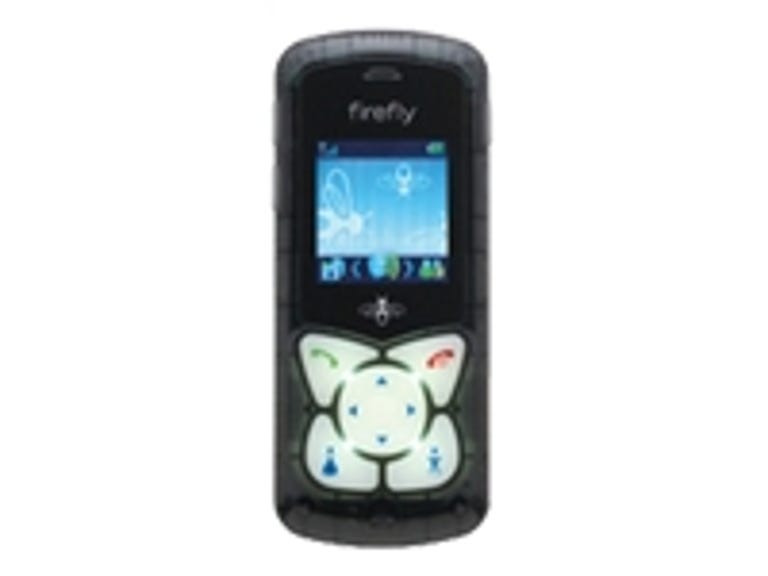The Firefly GlowPhone is one of two child-friendly cell phones from Firefly Mobile. While the company's FlyPhone offers standard cell phone features, the GlowPhone sticks to the bare basics while offering a high level of parental controls. In many ways it is a revamp of the original Firefly. Though it adds a better menu system and a more comfortable design, it lacks a traditional keypad and the capability to send text messages. Such limited functionality makes the GlowPhone a handset for children just hitting the double-digit ages; don't even try to pawn it off on the middle school set. For them, the higher-end FlyPhone is a more appropriate model. The GlowPhone is $49.99.
The Good
The Bad
The Bottom Line
Design
Though users of the original Firefly will recognize the GlowPhone's profile, Firefly made an effort to correct some of its predecessor's design errors. The see-through plastic shell remains but at 4.02 inches by 1.73 inches by 0.71 inch, the GlowPhone is bigger than the Firefly, which results in a more comfortable feel in the hand. It's also heavier (3.2 ounces versus 2.10 ounces) but it still feels a tad flimsy. The FlyPhone comes in two colors: pink and black. We reviewed the black version, but the features are the same for both models.

The 1.5 inch display is full color so it's greatly improved over the Firefly's monochrome screen. The menu interface remains pretty spartan, but the resolution (128x128-pixels) makes for better colors and graphics. In standby mode it shows the date time, battery life, and signal strength. You have one of eight wallpaper choices and can change the backlight time.

The GlowPhone's simple controls have the same design as on the Firefly. You'll find only Talk and End/power buttons, dedicated "Mom" and "Dad" calling keys (apologies to single and same-sex parents), and the five-way navigation toggle. Though the navigation array is spacious and all of the buttons are covered by a rubbery tactile material, only the toggle isn't flush. The volume rocker is in its usual place on the left spine, while the emergency button again rests in its exposed location on the right spine. A 2.5mm headset jack sits just below the emergency key, while the single speaker is on the GlowPhone's rear face. Like the FlyPhone, the GlowPhone has a mini USB on the bottom end that's used for charging.
="">FeaturesThe lack of keypad is intentional as the GlowPhone is designed to call only the numbers in its 50-contact phone book. Entering numbers in the phone book can be done only through the parental controls menu, which requires a PIN number. It takes time to do so, however, since there is no keypad. You can tell the handset to accept calls only from saved contacts, designate call forwarding and auto redial options, and lock out the text messaging feature.

Other features on the GlowPhone are slim. You can read, but not send text messages, which will displease messaging fans. Otherwise, you can make calls with the speakerphone, use the display as a flashlight, choose one of 120 polyphonic ringtones, and play one of four very basic games (Boxman, Snake, Mine, and Brick). The GlowPhone also includes voice mail, which was missing on the earlier Firefly model.
As an MVNO, Firefly doesn't operate a cellular network but it does have its own service plans. Both the pay-as-you-go and by-the-month options charge for each calling minute and text message, plus a daily access fee of 35 cents. The calling and texting rates for the latter plan are cheaper, but you're required to spend a minimum of $15 per month. Once your account balance is depleted, you can top it off on Firefly's Web site.
Performance
We tested the dual-band (GSM 850/1900) GlowPhone in San Francisco. Firefly uses AT&T's and T-Mobile's network, so your coverage will vary depending on which network you're using. Just keep in mind that the GlowPhone won't have service outside of the United States. Call quality was acceptable, but only for short periods. There was more feedback than on the FlyPhone and voice quality was somewhat diminished. On the upside, the volume was quite loud, particularly during speakerphone calls. On their end, some callers had trouble hearing us, especially when we were speaking in noisy environments. They could tell we were using a cell phone.
The Firefly GlowPhone has a rated battery life of five hours talk time and 8.75 days standby time.



